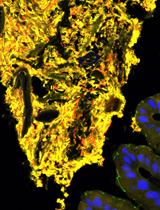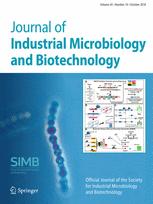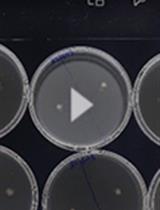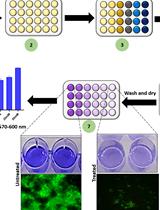- EN - English
- CN - 中文
Assembly of a Custom-made Device to Study Spreading Patterns of Pseudomonas putida Biofilms
用于恶臭假单胞菌生物膜扩散模式研究的定制设备的组装
(*contributed equally to this work) 发布: 2019年05月20日第9卷第10期 DOI: 10.21769/BioProtoc.3238 浏览次数: 4831
评审: Alba BlesaAnonymous reviewer(s)

相关实验方案

从沙门氏菌鼠伤寒血清中纯化细菌淀粉样蛋白“Curli”并检测受感染宿主组织中的 Curli
Murugesan Sivaranjani [...] Aaron P. White
2022年05月20日 3129 阅读
Abstract
Biofilms are bacterial communities in the shape of exopolysaccharide matrix-encased aggregates attached onto interphases able to resist environmental aggressions. The development of bacteria in the shape of biofilms deeply affects the performance of many industrial processes which work with fluidic systems, where bacteria may settle and prosper. As a consequence industrial equipment experiments low performance issues and substantial maintenance costs.
The study of how bacteria of industrial interest such as Pseudomonas putida spread in these fluidic systems is highly dependent on the chosen experimental system to retrieve such data, thus using scaled prototypes becomes an essential step towards the design of a more efficient system to handle biofilms, either to control them or to prevent them. This protocol describes how to assemble, operate and maintain a device to grow and monitor the biofilm spreading pattern of this bacterium (as a function of the fluid hydrodynamics) in a custom-made chamber larger than those typically used in laboratory environments, and how to analyze the information gathered from it in a straightforward fashion. Description of the protocol was thought to be used as a working template not only for the presented case study but for any other potential experiment in different contexts and diverse scales following similar design principles.
Background
The characterization of bacterial biofilm spreading pattern dynamics in fluidic systems is a key issue when trying to gain control of the proliferation of these living organisms. Especially relevant is the case of biofilm presence in industrial environments, where an uncontrolled growth may lead to large economic loses. Typical studies on this area focus their efforts on creating laboratory-scale setups to investigate the effect of different variables to test. These parameters are controlled to monitor subsequent biofilm expansion for every tested experimental condition. However extrapolating these results to an industrial-like fluidic environment is not so straightforward, as equipment, materials and operation conditions may deeply affect biofilm behavior. Furthermore the designs performed for laboratory-scale devices are in many cases incompatible with typical industrial equipment and procedures. As a consequence, the number of studies in the literature using industrial-like devices is very limited.
In this protocol we describe a procedure for assembling, testing and operating an industrial-like device to study the biofilm spreading pattern of platform strain Pseudomonas putida mt-2. The design and operation procedures of the device were specifically chosen to have into account constrains and features typically found when using industrial materials and equipment, delivering a viable solution for given research purposes.
Materials and Reagents
- Laboratory consumables
- 0.4 μm pore size nitrile filter (Millipore, catalog number: SLHA033SS)
- 0.45 μm PES filter unit (VWR, catalog number: 514-0335)
- Microscope slide (VWR, catalog number: 16004-422)
- Microscope cover slip (VWR, catalog number: 48393-026)
- Aluminum foil
- Marker pen
- Tubing
- 1 x 25 m 5.5 mm inner diameter flexible polyurethane tubing (Legris, catalog number: 1025U0805)
- 1 x Silicone tubing, 25 m, 2 mm (id) x 4 mm (od), (VWR, catalog number: 228-0704)
- 1 x Silicone tubing, 4 m, 4 mm (id) x 6 mm (od), (VWR, catalog number: 228-0709)
- Valves and clamps
- 8 x F-F ¼’ BSPP ball valve (RS, RS Pro, catalog number: 733-5202)
- 1 x ISMATEC 2 stop coded tubes, id: 1.65 mm (blue-blue, catalog number: SC0018), Mat: Tygon R-3607 (Cole Parmer, catalog number: EW-96460-38)
- 2 x hosecock clamp (VWR, catalog number: 21716-102)
- Connectors and fittings
- 1 x 8 mm–8 mm–8 mm Tee Legris (RS, catalog number: 445-4495)
- 14 x Legris Pneumatic Straight Threaded-to-Tube Adapter, R 1/4" Male, Push In 8 mm (RS, catalog number: 182-4784)
- 3 x SMC Pneumatic Straight Threaded-to-Tube Adapter, Rc 1/8" Female, Push In 8 mm (RS, catalog number: 771-5002)
- 2 x SMC Pneumatic Elbow Threaded-to-Tube Adapter, Push In 8 mm 1/4" thread (RS, catalog number: 771-6030)
- 2 x Legris Pneumatic Elbow Threaded Adapter, R 1/4" Male x R 1/4" Male (RS, catalog number: 367-5792)
- 2 x Legris Brass 1/4" in. BSPT Male Plug Threaded Fitting (RS, catalog number: 231-5045)
- 1 x Legris Pneumatic Tee Threaded-to-Tube Adapter, 1/4". x 8 mm x 8 mm, 30 bar (RS, catalog number: 225-0617)
- 1 x Barbed fittings, Straight Connector, Natural PP, 1/8" ID; 10/pk (Cole-Parmer, catalog number: EW-51518-05)
- Barbed Tee Connector, Polypropylene, 1/8"; 25/pk (Cole-Parmer, catalog number: SI-50623-66)
- 1 x ADCF Male Luer to 1/8" L Barb Adapter, Polypropylene, 25/pk (Cole-Parmer, catalog number: SI-30800-24)
- 1 x ADCF Female Luer to 1/8" L Barb Adapter, Polypropylene, 25/pk (Cole-Parmer, catalog number: SI-30800-08)
- Accessories
- Electrical Tape, 19 mm x 20m (RS, catalog number: 511-4306)
- Socket extension lead (RS, catalog number: 122-1105)
- 1 x Clear Polycarbonate PC Sheet, 1.25 m x 610 mm x 6 mm (RS, catalog number: 681-665)
- 1 x Nitrile rubber O-Ring Cord, 2 mm diameter (RS, catalog number: 138-1600)
- 1 x White PTFE Tape 12 mm x 12 m x 0.075 mm (RS, catalog number: 512-238)
- 1 x Pan Head Bright Zinc Plated Steel Machine Screw bag, M3, 20 mm (RS, catalog number: 560-625)
- 1 x Stainless Steel, Hex Nut bag, M3 (RS, catalog number: 189-563)
- 1 x Stainless Steel Plain Washer, 0.5 mm Thickness, M3 (RS, catalog number: 189-620)
- 1 x Cyanoacrylate glue (RS, catalog number: 533-478)
- Chemicals
- Gentamycin (Sigma-Aldrich, catalog number: PHR1077-1G)
- Absolute Ethanol (Sigma-Aldrich, catalog number: 1009832500)
- NaClO (VWR, catalog number: 470302-586)
- Glycerol 85% (Sigma-Aldrich, catalog number: 1040942500)
- Na2HPO4·2H2O (Sigma-Aldrich, catalog number: 71643-250G)
- KH2PO4 (Sigma-Aldrich, catalog number: P5655-500G)
- NaCl (Sigma-Aldrich, catalog number: S3014-1KG)
- NH4Cl (Sigma-Aldrich, catalog number: A9434-500G)
- MgSO4 (Sigma-Aldrich, catalog number: M2643-500G)
- 10x M9 salts stock (see Recipes)
- 20% Glycerol (see Recipes)
- 1 M MgSO4 (see Recipes)
- M9 minimal medium supplemented with 0.2% (w/v) glycerol (see Recipes)
Equipment
- 2 x 2 L Pyrex® narrow-mouth Erlenmeyer flask (Sigma-Aldrich, catalog number: CLS49802L)
- 3 x 1 L Pyrex® narrow-mouth Erlenmeyer flask (Sigma-Aldrich, catalog number: CLS49801L)
- 1x DuranTM 4-Port Assembled HPLC Screw Caps GL-45 (Fisher Scientific, catalog number: 10740834)
- 1 x 1 L Laboratory bottles with screw cap, DURAN® GL-45 (VWR, catalog number: 215-1517)
- 1 x 5 L BRAND® PP beaker with spout, low form (Sigma-Aldrich, catalog number: BR87826-4EA)
- 1 x 16 mm length magnetic stirring bar (VWR, catalog number: 442-0366)
- 1 x 250 x 250 mm magnetic stirrer (VWR, catalog number: 444-0572)
- Orbital shaker
- 1 x Flowmeter (Aalborg P-150 mm, 1/4" FNTP fitting, catalog number: P11A3-BB0)
- 2 x 12VDC Pumps (EKWD, EK-DCP 2.2, catalog number: 3831109862506)
- 3 x 220V AC/12V DC adaptor (RS Online, catalog number: 737-8149)
- 1 x 19-37.8 L aquarium air pump (Hagen, A842 Aquaclear Air pump 10, catalog number: 15561108447)
- 1 x Ismatec IPC-N ISM936D IPC-N (ISM936D) Low-Speed Digital Peristaltic Pump with Click-'N-Go Cartridges; 8-Channel, 230V (Cole-Parmer, catalog number: EW-78001-16)
- 1 x Adjustable Spanner (RS, catalog number: 469-7018)
- 1 x EMCO Concept Mill 105 milling machine
- 1x Fluorescence microscope with the following features:
- Light source and light filter to allow visualization of GFP and Texas Red fluorochromes
- Monochrome digital camera with EMCCD chip (minimum requirement)
- Motorized tray for automatic XY displacement and automatic tile-scan acquisition
- Automatic Z autofocus
Software
- Scientific programming language (i.e., MATLAB) or general purpose programming language (i.e., Python, C+) able to work with scientific computing packages supporting basic statistic functions (i.e., mean, standard deviation), array/structure manipulation (array sorting, length) and element selection operators (unique elements)
- Image treatment library for selected program language (i.e., scikit-image for Python, Image processing toolbox for MATLAB)
- Image treatment software (ImageJ or equivalent) containing a proper library to open microscope files with native formats (i.e., *.lif), or microscope-related software able to perform regular format file storage
Procedure
文章信息
版权信息
© 2019 The Authors; exclusive licensee Bio-protocol LLC.
如何引用
Espeso, D. R., Martínez-García, E. and Lorenzo, V. D. (2019). Assembly of a Custom-made Device to Study Spreading Patterns of Pseudomonas putida Biofilms. Bio-protocol 9(10): e3238. DOI: 10.21769/BioProtoc.3238.
分类
微生物学 > 微生物生物膜 > 生物膜培养
微生物学 > 群落分析 > 空间互作
您对这篇实验方法有问题吗?
在此处发布您的问题,我们将邀请本文作者来回答。同时,我们会将您的问题发布到Bio-protocol Exchange,以便寻求社区成员的帮助。
Share
Bluesky
X
Copy link












